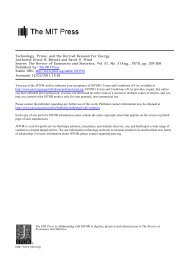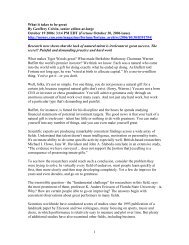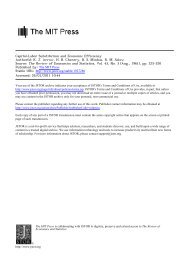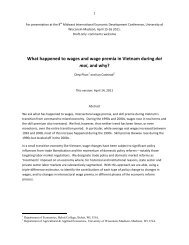Status of Wisconsin Agriculture 2010 - Agricultural & Applied ...
Status of Wisconsin Agriculture 2010 - Agricultural & Applied ...
Status of Wisconsin Agriculture 2010 - Agricultural & Applied ...
You also want an ePaper? Increase the reach of your titles
YUMPU automatically turns print PDFs into web optimized ePapers that Google loves.
The General Economy<br />
and <strong>Agricultural</strong> Trade<br />
Bill Dobson (608-262-6974)<br />
Synopsis<br />
II. Current Outlook: <strong>Wisconsin</strong> <strong>Agricultural</strong> Commodities,<br />
Production Inputs and the General Economy<br />
In this section, analysts <strong>of</strong>fer their insights on economic conditions for <strong>Wisconsin</strong> agriculture. Forecasts are<br />
provided for major <strong>Wisconsin</strong> farm commodities, farming inputs and the general economy. Because <strong>of</strong> the<br />
lingering effects on agriculture <strong>of</strong> the global financial crisis that began in late 2008, we begin this section<br />
with a detailed discussion <strong>of</strong> the current macroeconomic environment and what to expect in <strong>2010</strong> after what<br />
was a financially challenging 2009 for most <strong>Wisconsin</strong> farmers. Interested readers are encouraged to contact<br />
authors for more current or more detailed information regarding their analyses.<br />
Many economists have labeled the<br />
2008-2009 contraction as the Great<br />
Recession, categorizing it as the<br />
sharpest economic downturn since<br />
the Great Depression <strong>of</strong> the 1930s.<br />
The 2008-2009 recession clearly<br />
was among the worst in recent history,<br />
global in reach, and one that<br />
will produce a legacy <strong>of</strong> high unemployment<br />
and subdued economic<br />
growth in the United States.<br />
The stages <strong>of</strong> the Great Recession <strong>of</strong><br />
2008-2009 as measured by changes<br />
in real Gross Domestic Product<br />
(GDP) will trace out a U-shaped figure<br />
with a broad and irregular bottom<br />
and a gently sloping right side<br />
that denotes a slow recovery. While<br />
real GDP grew by a welcome 2.2<br />
percent in the 3rd quarter <strong>of</strong> 2009,<br />
this does not signal the return <strong>of</strong><br />
strong, sustained economic growth.<br />
Indeed, expect real GDP growth in<br />
<strong>2010</strong> to average only 2.0 to 2.5 percent.<br />
Moreover, unemployment,<br />
which rose to 10.2 percent in October<br />
2009, is likely to stay above 7<br />
percent until 2013 or 2014.<br />
Aggressive U.S. fiscal and monetary<br />
policies have helped to reduce<br />
impacts <strong>of</strong> the economic crisis that<br />
began in 2008 and produce a potentially<br />
sustainable recovery. But<br />
headwinds have developed in the<br />
wake <strong>of</strong> the Great Recession that<br />
will hamper the emergence <strong>of</strong> a<br />
smooth and rapid recovery. These<br />
come in the form <strong>of</strong> stubbornly high<br />
unemployment, weak business<br />
investment, budget problems <strong>of</strong><br />
state governments, challenges for<br />
the domestic auto industry, problems<br />
in commercial real estate markets<br />
and credit problems for small<br />
businesses.<br />
The U.S. agricultural sector was hit<br />
hard by the global recession. The<br />
USDA estimated that U.S. net farm<br />
income fell to $54 billion in 2009,<br />
down $33.2 billion (38 percent)<br />
from the near record total <strong>of</strong> $87.2<br />
billion for 2008. Problems in the<br />
sector contributed to a rare 3.2 percent<br />
drop in U.S. farm real estate<br />
prices on January 1, 2009. U.S. agricultural<br />
exports in fiscal 2009 fell to<br />
$96.6 billion, down 16 percent from<br />
the record, year-earlier total <strong>of</strong><br />
$115.3 billion. The weak U.S. dollar<br />
and other developments promise to<br />
help maintain U.S. agricultural<br />
exports in <strong>2010</strong> near the 2009 level.<br />
U.S. agricultural businesses experienced<br />
many <strong>of</strong> the problems that<br />
beset their counterparts in the nonagricultural<br />
sector. But longer-term<br />
prospects <strong>of</strong> many agribusinesses<br />
appear reasonably bright.<br />
After <strong>2010</strong>, U.S. policymakers will<br />
face the challenge <strong>of</strong> reducing federal<br />
deficits to manageable levels.<br />
Failure to meet the challenge will<br />
Macroeconomic Statistics for the U.S. Economy<br />
Year or Real GDP Unemploy- Inflation Housting Federal Sur-<br />
Quarter Growth ment Rate Rate (CPI) Starts plus/Defecit<br />
% % % Mil. Units $ Billion<br />
2000 3.7 4.0 3.4 1.57 236.1<br />
2001 0.8 4.7 2.8 1.601 126.9<br />
2002 1.8 5.8 1.6 1.710 -160.3<br />
2003 2.5 6.0 2.3 1.854 -375.2<br />
2004 3.6 5.5 2.7 1.950 -411.1<br />
2005 3.1 5.1 3.4 2.073 -321.0<br />
2006 2.7 4.6 3.2 1.812 -248.2<br />
2007 2.1 4.6 2.9 1.342 -161.5<br />
2008 0.4 5.8 3.8 0.900 -454.8<br />
2009 Q1 -6.4 8.1 -2.4 0.528 -448.9<br />
Q2 -0.7 9.3 1.3 0.540 -304.9<br />
Q3 2.2 9.6 3.6 0.590 -330.8<br />
*Sources: Global Insight, U.S. Executive Summary, various issues 2007-2009. Quarterly<br />
housing start figures for 2009 represent estimates <strong>of</strong> annualized figures for the series.<br />
STATUS OF WISCONSIN AGRICULTURE <strong>2010</strong>—CURRENT OUTLOOK: GENERAL ECONOMY AND AGRICULTURAL TRADE 7







